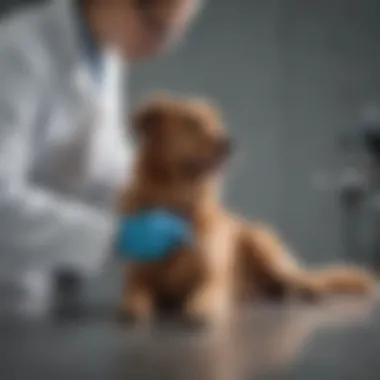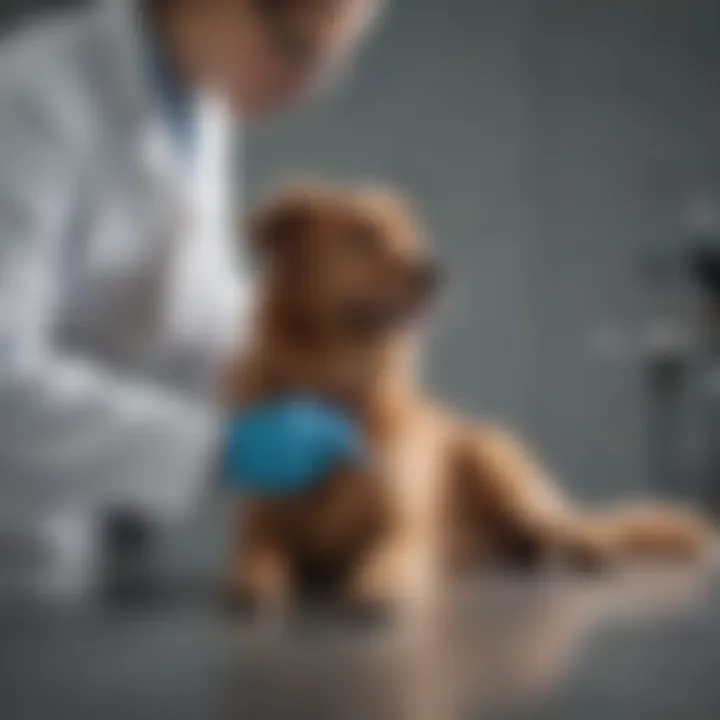E. Coli Infections in Dogs: Causes and Treatments


Intro
E. coli infections in dogs' urine present a significant concern for pet owners and veterinary professionals alike. The bacterium Escherichia coli is commonly found in the intestines of healthy animals; however, certain strains can lead to urinary tract infections (UTIs) when they escape their normal habitat. Understanding this condition involves exploring various aspects such as causes, symptoms, treatment options, and prevention strategies.
This article aims to equip readers with a comprehensive understanding of E. coli infections in dogs. By examining the mechanisms of bacterial pathogenicity, we highlight the importance of recognizing symptoms early and implementing effective treatment. As antibiotic resistance becomes an increasingly pressing issue, knowledge of current therapies and their management is essential. Moreover, awareness of preventive measures can significantly reduce the likelihood of future occurrences, thereby safeguarding the health of our canine companions.
Through this guide, students, researchers, educators, and professionals will gain valuable insights into a topic that is critical for both animal welfare and public health.
Preface to E. coli Infections in Dogs
E. coli infections in dogs are a significant concern for pet owners and veterinary professionals alike. Understanding this topic is vital because it encompasses not just the biological aspects of Escherichia coli but also its impact on canine health. Infections can lead to severe urinary tract issues, which if left untreated, may cause serious complications.
Knowledge about E. coli in dogs enables timely recognition of symptoms and appropriate interventions. This knowledge can ultimately lead to better outcomes for our pets. Additionally, the ongoing rise of antibiotic resistance in veterinary medicine makes it essential to scrutinize treatment options closely. By exploring how E. coli affects dogs, we can also identify preventive measures that may help mitigate these risks.
The significance of this section lies in equipping pet owners with the right information. Besides basic biology, it allows for a deeper understanding of the infection's prevalence and management strategies. This understanding benefits both pet owners, who wish to keep their dogs healthy, and the veterinary community, which strives to provide effective care.
Overview of Escherichia coli
Escherichia coli, commonly known as E. coli, is a type of bacteria that exists in the intestines of many animals, including dogs. Most strains are harmless and play a crucial role in helping digestion. However, certain pathogenic strains can lead to infections, particularly in the urinary tract.
E. coli infections in dogs often arise from the bacteria's ability to travel from the intestines to the urinary tract. Factors such as a weakened immune system or anatomical predispositions can increase the likelihood of infection. It is critical for pet owners to understand these dynamics to promote better health management for their pets.
Prevalence of E. coli in Canine Urinary Tract Infections
Research indicates that E. coli is one of the most common causes of urinary tract infections (UTIs) in dogs. Estimates suggest that up to 80% of canine UTIs are attributed to this bacterium. This prevalence makes awareness and understanding of E. coli infections particularly crucial for those caring for dogs.
Several factors contribute to this high prevalence, such as:
- Anatomical Differences: Female dogs are more susceptible due to their shorter urethra.
- Behavioral Habits: Dogs that frequently traverse areas with high microbial load may also be at higher risk.
- Underlying Health Issues: Conditions like diabetes or kidney disease can predispose dogs to infections.
Given the frequency of E. coli as a causative agent in dog urinary tract infections, it is essential for owners to be informed about the risks, symptoms, and treatment options available. This information lays the groundwork for effective management of potential infections.
Understanding Urinary Tract Infections
E. coli infections stand out as a significant feline health issue, particularly related to the urinary tract. To comprehend why these infections present such risks to dogs, one must first grasp the broader context of urinary tract infections (UTIs). Understanding the mechanisms behind these infections can lead to better management and treatment strategies. The urinary system plays a crucial role in eliminating waste and maintaining overall health.Familiarity with how infections take root provides vital insights that guide treatment plans.
The Anatomy of the Urinary System in Dogs
The urinary system in dogs consists primarily of the kidneys, ureters, bladder, and urethra. Each part performs a specific function in the process of waste removal.
- Kidneys: These organs filter blood, removing waste products and excess fluids to produce urine.
- Ureters: Each kidney has a ureter connecting it to the bladder. These tubes carry urine from the kidneys.
- Bladder: The unique bladder holds urine until it needs to be excreted. Its muscular wall allows for expansion and contraction.
- Urethra: This tube conveys urine from the bladder to outside the body during urination.
Understanding these structures helps in identifying the points where infections may occur and their potential consequences. For instance, infections can initiate in any part of this system, often leading to persistent discomfort and further complications.
How Infections Occur
Infections in the urinary system typically arise from bacterial invasion. These bacteria may enter through various pathways, with E. coli being the most prevalent. The circumstances leading to urinary tract infections include:
- Contamination: Bacteria from the skin, feces, or surroundings can contaminate the urinary tract.
- Hormonal Changes: Fluctuations in hormones can create favorable conditions for bacteria to thrive.
- Urinary Retention: Incomplete emptying of the bladder provides a breeding ground for bacteria.
- Underlying Conditions: Factors like diabetes, kidney stones, or anatomical abnormalities can increase the risk of infections.
Infections often develop due to a combination of these elements. Understanding how these infections take root is essential for effective prevention and treatment strategies.
Effective management starts with awareness of how infections initiate, which can lead to prompt interventions.
In summary, a thorough understanding of UTIs is fundamental for recognizing symptoms, implementing preventive measures, and ensuring timely treatment of E. coli infections in dogs.


Symptoms of E. coli Infections in Dogs
Understanding the symptoms of E. coli infections in dogs is crucial for timely intervention and effective management. E. coli, a bacterium commonly associated with urinary tract infections (UTIs), can lead to serious health issues if not addressed promptly. Recognizing clinical signs early can spare pets from discomfort and prevent the escalation of health complications. Pet owners play a significant role in this process. They are often the first to observe changes in their dog's behavior and health. Therefore, educating yourself about the symptoms is essential for your dog's well-being.
Common Clinical Signs
Dogs suffering from E. coli infections may exhibit several distressing symptoms. These signs are not always specific, as they can overlap with other conditions. However, familiarizing yourself with them can make a significant impact on your dog's health.
Typical symptoms may include:
- Frequent urination, often with little urine produced
- Painful urination, indicated by whimpering or restlessness
- Blood in urine, which can vary from bright red to dark brown
- Strong-smelling urine, which may suggest infection
- Licking of the genital area more than usual
- Increased thirst, leading to more frequent drinking
- Lethargy or decreased activity levels
- Vomiting or mild fever in some cases
Monitoring these clinical signs can help in identifying an E. coli infection early. Thus, if you notice any of these symptoms, consult a veterinarian promptly. Early detection is key to curbing the infection's impact on your dog's health.
Complications Related to Delayed Treatment
Delaying treatment for E. coli infections in dogs can result in severe health consequences. When infections go untreated, the bacteria can spread from the urinary tract to other organs, leading to systemic infections.
Possible complications include:
- Kidney infections (Pyelonephritis): This serious condition can occur when bacteria travel back to the kidneys, causing inflammation and potential kidney failure.
- Bladder inflammation (Cystitis): Prolonged infections can lead to chronic cystitis, which requires more extensive treatment and management.
- Sepsis: A more severe complication where the body responds poorly to infection, potentially leading to multi-organ failure.
"Timely treatment reduces the risk of complications and improves recovery outcomes."
The importance of addressing these symptoms cannot be overstated. Every moment that passes without treatment can move your dog closer to these severe health issues. Therefore, knowledge about the symptoms, coupled with quick action, can lead to better health outcomes for your pet.
Diagnosis of E. coli Infections
Diagnosing E. coli infections in dogs is crucial for effective treatment. Early diagnosis can significantly impact recovery and minimize complications. Understanding the signs and symptoms that lead to diagnosis is essential for both pet owners and veterinary professionals. As urinary tract infections (UTIs) are common in dogs, distinguishing E. coli as the causative agent is vital. This specific knowledge equips vets to choose the most effective treatment options.
Veterinary doctors rely on a combination of physical examinations, laboratory testing, and systematic differential diagnoses to identify E. coli infections. The following sections will elaborate on each component of the diagnostic process, emphasizing their importance and implications for successful management.
Veterinary Examination Protocols
When a dog shows signs of a urinary tract infection, a thorough veterinary examination is the first step. This examination typically includes several components:
- Medical History: Vets start by gathering the dog's medical background, any previous infections, and current medications.
- Physical Examination: Vets check for visible symptoms such as fever, pain during urination, or abnormal behavior. Palpation of the abdomen can help identify pain or discomfort, indicating potential infection.
- Behavioral Observations: Understanding the dog's behavior, including changes in drinking, urinating, or appetite, can help provide context to the symptoms.
By following these protocols, veterinarians gather essential information, leading them closer to an accurate diagnosis of E. coli infections in a dog's urinary system.
Laboratory Testing: Urinalysis and Cultures
Laboratory testing forms the cornerstone of confirming E. coli infections in dogs. Two primary tests are critical:
- Urinalysis: This initial test examines the dog’s urine. It can reveal the presence of white blood cells, bacteria, and glucose, indicating an infection or other urinary issues. The presence of specific bacteria can point toward E. coli as a probable cause.
- Urine Culture: This more definitive test involves culturing a sample of the dog's urine in a laboratory setting. If E. coli grows from the culture, it confirms the diagnosis. This test not only identifies the infecting organism but also demonstrates its antibiotic sensitivity, critical for choosing the right treatment.
Both tests enhance diagnostic accuracy and support timely intervention, which is essential in preventing complications that may arise from untreated infections.
Differential Diagnosis Processes
Differential diagnosis is a systematic approach to rule out other possible causes of the observed symptoms in dogs. A few conditions that could mimic E. coli infections include:
- Other Bacterial Infections: Other pathogens may cause similar symptoms. Identifying the specific organism is vital for effective treatment.
- Bladder Stones or Crystals: These can also lead to issues like painful urination or blood in urine. Imaging tests may be necessary to detect them.
- Neoplasia: Tumors in the urinary system can produce similar clinical signs and require different management approaches.
This careful process makes sure that all potential causes are evaluated. It is important because treatment strategies can vary significantly based on the actual diagnosis.
A precise diagnosis facilitates timely treatment, significantly enhancing the outcomes for dogs suffering from urinary infections and helps to prevent complications.


Understanding the diagnostic process allows pet owners to navigate veterinary visits confidently and supports veterinary professionals in offering the best possible care.
Treatment Options for E. coli Infections
E. coli infections in dogs require prompt and effective treatment to avoid complications. The focus of treatment options is to eliminate the bacteria while also addressing symptoms and preventing recurrence. Understanding various approaches, including antibiotic therapy, supportive care, and alternative methods, is crucial for both owners and veterinarians. This section explores these treatment modalities and highlights their importance.
Antibiotic Therapy: Indications and Choices
Antibiotic therapy remains the cornerstone for managing E. coli infections in dogs. The choice of antibiotics must be based on specific indications such as the severity of the infection, the dog’s health status, and local antibiotic resistance patterns. Commonly used antibiotics include amoxicillin, enrofloxacin, and cephalexin. Each of these has distinct mechanisms of action and efficacy against different strains of E. coli.
When selecting an antibiotic, a veterinarian may consider:
- Sensitivity Testing: Urine cultures help identify the specific strain of E. coli and its resistance profile. This informs the choice of medication to ensure effective treatment.
- Duration of Treatment: Typically, a course of antibiotics lasts from 7 to 14 days. However, longer treatment may be required for more chronic cases.
- Monitoring for Side Effects: Potential adverse effects must be monitored, as some dogs can experience gastrointestinal disturbances or allergic reactions.
In some cases, combination therapy may be used to enhance treatment efficacy and mitigate resistance development. Owners must follow the prescribed regimen closely to avoid complications, such as treatment failure or recurrence of infection.
Supportive Care and Management Strategies
In addition to antibiotic therapy, supportive care is vital in managing E. coli infections. Supportive care includes interventions aimed at improving the overall well-being of the dog during the treatment process. This may involve:
- Hydration: Ensuring the dog stays well-hydrated is crucial. Increased fluid intake helps flush bacteria from the urinary tract, promoting recovery.
- Diet Modification: A balanced diet, ideally incorporating moisture-rich foods, can support urinary health. Special diets may include added fiber or probiotics to enhance gut health and immune function.
- Rest: Limiting physical activity can be beneficial, allowing the dog's body to focus energy on fighting the infection.
Regular monitoring of symptoms is essential. Owners should check for improvements and ensure there are no signs of adverse effects from treatments. Tracking the dog's comfort and recovery may guide further decisions in management.
Alternative Treatment Approaches
The rising concern over antibiotic resistance has driven interest in alternative treatment strategies for E. coli infections. While these methods should not replace conventional treatments, they can be considered complementary options.
- Probiotics: Introducing beneficial bacteria through supplements may help to restore the balance of gut flora and support the immune system.
- Herbal Remedies: Some owners explore herbal treatments such as cranberry extract, which has been shown to prevent bacterial adhesion to the urinary tract, though more research is needed.
- Homeopathy: Some might consider homeopathic treatments as an adjunct to conventional methods. However, the efficacy of such treatments varies, and it is important to consult with a veterinarian familiar with these practices.
Alternative treatments should always be discussed with a veterinarian. Each dog’s situation is unique, and what may work for one pet may not be appropriate for another. A coordinated approach that integrates both conventional and alternative treatments may optimize recovery outcomes.
Challenges in Treating E. coli Infections
Treating E. coli infections in dogs presents several complexities that veterinarians and pet owners must navigate. Understanding these challenges is crucial for effective management and treatment outcomes. The rise of antibiotic resistance, coupled with the incidence of recurrent infections, creates a difficult landscape for treatment. These issues impact the ability to provide optimal care and highlight the need for a comprehensive approach to managing these infections.
Antibiotic Resistance Issues
Antibiotic resistance is a significant concern in the treatment of E. coli infections in dogs. Over-reliance on antibiotics can lead to resistant strains of bacteria, making infections harder to treat. This scenario is exacerbated by incorrect usage of antibiotics, such as not completing a prescribed course or using them for unapproved purposes.
Pet owners and veterinarians must work together to mitigate this issue. Some important factors include:
- Judicious Use of Antibiotics: Only administer antibiotics when necessary, and choose the right drug based on specific bacterial cultures.
- Monitoring Treatment Success: Follow-up assessments can identify whether the infection is responding to treatment.
- Educating Owners: Ensuring pet owners understand the importance of adherence to prescribed treatments can make a difference.
Recurrent Infections: Causes and Solutions
Recurrent urinary tract infections due to E. coli can be frustrating for both dogs and their owners. Identifying the underlying causes is essential to prevent these episodes. Several factors can contribute to recurrence:
- Incomplete Treatment: Sometimes, infections may appear resolved; however, the bacteria can persist if antibiotics are not taken for the full duration.
- Underyling Health Issues: Conditions such as diabetes or kidney disease may predispose dogs to recurrent infections.
- Environmental Factors: Poor hygiene or lack of proper bathroom habits can introduce bacteria into the urinary tract repeatedly.
Addressing recurrent infections involves a multi-faceted approach:
- Regular Veterinary Visits: Continuous health assessments can catch underlying conditions early.
- Improved Hygiene Practices: Keeping living areas clean and ensuring dogs are properly groomed may help reduce bacteria exposure.
- Dietary Modifications: A balanced diet can support a robust immune system, potentially reducing infections.
Monitoring and adapting management strategies is vital to prevent the recurrence of E. coli infections in dogs.


Recognizing these challenges in treating E. coli infections is the first step to managing them effectively. Careful monitoring, education, and a proactive approach can significantly improve outcomes for affected dogs.
Preventive Measures for Urinary Tract Infections
Preventive measures against urinary tract infections (UTIs) are crucial for maintaining the health of dogs and minimizing the recurrence of E. coli infections. Attention to prevention can alleviate the burden on both pets and their owners. This section examines effective strategies to mitigate the risk of infections while emphasizing their significance in a broader context.
Hygiene and Environmental Management
Hygiene plays a vital role in preventing UTIs in dogs. Regular cleaning of the dog’s living area and eliminating waste promptly can drastically reduce the chances of bacterial exposure. This means maintaining clean bedding, as well as ensuring any areas where the dog spends time outdoors are also clear of waste. More specifically, pet owners should wash dog bedding frequently and disinfect surfaces that the dog frequents. Additionally, keeping the genital area clean is essential. Regular bathing and gentle cleaning can prevent bacteria from accumulating in sensitive areas.
It is also important to consider the environment where the dog lives. Access to clean water and the availability of outdoor spaces for urination are important factors. Ensuring that the yard is secure can prevent dogs from roaming in areas where they may be exposed to harmful bacteria.
Dietary Considerations
Diet can significantly impact a dog’s urinary health. A balanced diet helps maintain an optimal pH balance in urine, which makes it less conducive for bacteria to thrive. Proper hydration is essential; encouraging drinking water can help dilute the urine and flush out any bacteria present. Manufacturers like Royal Canin produce specialized diets aimed at maintaining urinary tract health. Additionally, avoiding table scraps and foods known to irritate the bladder can reduce the risk of infection.
Some pet owners may consider incorporating dietary supplements such as cranberry extract. This ingredient is believed to support urinary tract health. However, it is essential to consult with a veterinarian before making any significant dietary changes to ensure they are appropriate for the specific dog.
Regular Veterinary Check-Ups
Regular veterinary check-ups form an integral part of preventing E. coli infections. Routine examinations can identify underlying health issues that may predispose a dog to UTIs. These visits provide an opportunity for veterinary professionals to assess the dog's overall health and kidney function, which is critical for preventing infections.
During these check-ups, urinalysis can be performed to detect any early signs of infection. Early intervention is key, as it can prevent more serious complications down the line. Additionally, such evaluations allow for tailored advice from veterinarians regarding both diet and hygiene practices based on the specific health status of the dog.
In summary, preventive measures against urinary tract infections encompass hygiene practices, dietary management, and regular veterinary visits. These actions serve not only to protect the dog but also to ensure peace of mind for the owner. Encapsulating these strategies is essential for minimizing the occurrence of E. coli infections and promoting overall canine well-being.
The Role of Owners in Managing E. coli Infections
The role of pet owners in managing E. coli infections in their dogs is pivotal. Understanding the responsibilities in this context can significantly influence the health outcomes for their pets. Owners not only need to be vigilant about recognizing early signs of infection but also must engage actively in the treatment processes prescribed by veterinarians. Their involvement can enhance recovery rates and prevent recurrences of urinary tract infections.
Recognizing Symptoms Early
Early recognition of symptoms is crucial in managing E. coli infections. Dogs can exhibit various signs that indicate a urinary tract infection, such as frequent urination, straining when urinating, blood in the urine or foul-smelling urine. Owners should pay attention to any unusual behavior. For instance, if a dog starts to frequently lick its genital area or appears uncomfortable when lying down, these could be indications of an underlying infection. By noting these changes promptly, owners can facilitate quicker veterinary intervention.
Furthermore, regular monitoring of a dog’s urination patterns can help owners catch issues early. It suggests a proactive approach to health. Recognizing symptoms early not only benefits treatment outcomes but also helps mitigate more serious health complications that can arise from untreated infections.
Adhering to Treatment Plans
Once a dog has been diagnosed with an E. coli infection, adherence to the treatment plan is essential. Treatment usually involves a course of antibiotics to eliminate the bacterial infection. It is important that owners follow the prescribed dosage and duration for medications. Stopping an antibiotic prematurely can lead to resistance or incomplete eradication of the bacteria.
Supportive care is another key aspect of the treatment process. This can include ensuring the dog has access to clean water and providing a safe and comfortable environment for recovery. In some cases, dietary adjustments may also be beneficial, such as incorporating specific urinary health diets.
Moreover, regular follow-up appointments with the veterinarian can help assess the effectiveness of the treatment. Owners should be prepared to discuss any ongoing symptoms or concerns during these visits. Keeping detailed notes on the dog's behavior and urination can provide useful insights for the veterinarian.
By actively participating in their pets’ care, owners play an integral role in the management of E. coli infections and overall urinary health.
Epilogue
Understanding E. coli infections in dogs is critical for both pet owners and veterinary professionals. The information presented throughout the article offers valuable insights into the complexities of these infections. When addressing issues related to canine urinary tract infections, it is imperative to recognize early symptoms and adhere to treatment plans promptly. This proactive approach can significantly reduce complications and enhance recovery outcomes for affected dogs.
Among the key points discussed, it is essential to emphasize the role of antibiotic resistance, which can complicate treatment efforts. By being informed about the prescribed therapies and potential alternative treatments, owners can better manage their pet's health and contribute to the ongoing efforts in combating bacterial resistance.
Additionally, preventive measures play a cornerstone role in maintaining canine health. Regular veterinary check-ups and proper hygiene contribute to a safer environment, reducing the risk of recurrent infections. Through vigilance and careful management, owners can greatly enhance their dog's quality of life. Overall, the importance of educating pet owners cannot be understated, as this knowledge equips them with the tools necessary to tackle E. coli infections effectively.
Summary of Key Points
- E. coli is a primary cause of urinary tract infections in dogs. Recognizing the symptoms early allows for prompt intervention.
- Treatment typically involves antibiotic therapy and supportive care. Owners must adhere to treatment plans to ensure optimal recovery.
- Antibiotic resistance is an emerging concern. Understanding medication choices can help mitigate this issue.
- Preventive measures are vital. Regular veterinary check-ups and good hygiene practices can minimize infection risks.
The Importance of Ongoing Research
Ongoing research is critical in the field of veterinary medicine, particularly concerning E. coli infections. New studies aim to better understand the pathogen's resistance mechanisms and explore innovative treatment modalities. Future research may provide insights into more effective vaccines or therapeutic strategies, potentially reducing the incidence of infections in both dogs and other animals.
Furthermore, as antibiotic resistance continues to rise, research is increasingly focusing on alternative treatment options that minimize the reliance on traditional antibiotics. Collaboration between veterinary researchers and practitioners can lead to improved guidelines and protocols for managing E. coli infections, advancing the overall quality of care available to pets.



